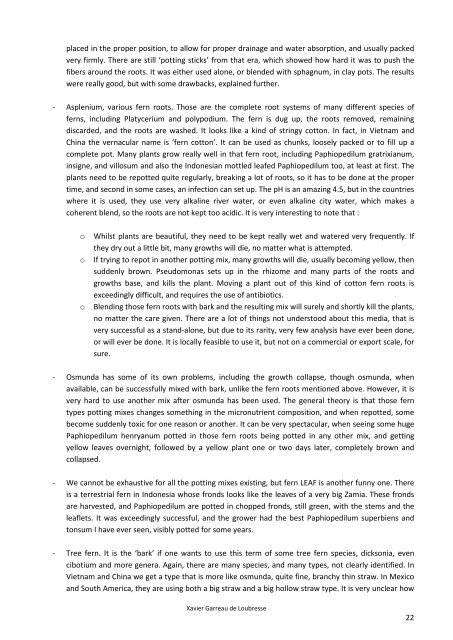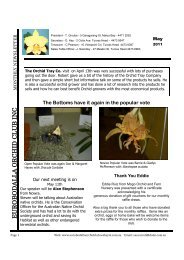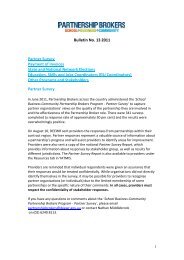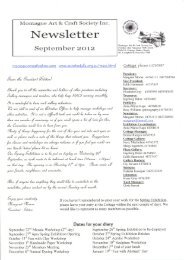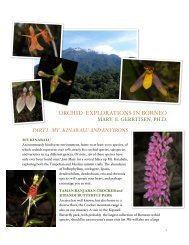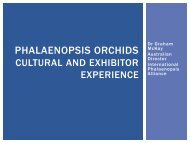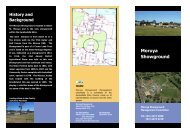Orchid Growing Substrates
Orchid Growing Substrates
Orchid Growing Substrates
Create successful ePaper yourself
Turn your PDF publications into a flip-book with our unique Google optimized e-Paper software.
placed in the proper position, to allow for proper drainage and water absorption, and usually packed<br />
very firmly. There are still ‘potting sticks’ from that era, which showed how hard it was to push the<br />
fibers around the roots. It was either used alone, or blended with sphagnum, in clay pots. The results<br />
were really good, but with some drawbacks, explained further.<br />
- Asplenium, various fern roots. Those are the complete root systems of many different species of<br />
ferns, including Platycerium and polypodium. The fern is dug up, the roots removed, remaining<br />
discarded, and the roots are washed. It looks like a kind of stringy cotton. In fact, in Vietnam and<br />
China the vernacular name is ‘fern cotton’. It can be used as chunks, loosely packed or to fill up a<br />
complete pot. Many plants grow really well in that fern root, including Paphiopedilum gratrixianum,<br />
insigne, and villosum and also the Indonesian mottled leafed Paphiopedilum too, at least at first. The<br />
plants need to be repotted quite regularly, breaking a lot of roots, so it has to be done at the proper<br />
time, and second in some cases, an infection can set up. The pH is an amazing 4.5, but in the countries<br />
where it is used, they use very alkaline river water, or even alkaline city water, which makes a<br />
coherent blend, so the roots are not kept too acidic. It is very interesting to note that :<br />
o<br />
o<br />
o<br />
Whilst plants are beautiful, they need to be kept really wet and watered very frequently. If<br />
they dry out a little bit, many growths will die, no matter what is attempted.<br />
If trying to repot in another potting mix, many growths will die, usually becoming yellow, then<br />
suddenly brown. Pseudomonas sets up in the rhizome and many parts of the roots and<br />
growths base, and kills the plant. Moving a plant out of this kind of cotton fern roots is<br />
exceedingly difficult, and requires the use of antibiotics.<br />
Blending those fern roots with bark and the resulting mix will surely and shortly kill the plants,<br />
no matter the care given. There are a lot of things not understood about this media, that is<br />
very successful as a stand-alone, but due to its rarity, very few analysis have ever been done,<br />
or will ever be done. It is locally feasible to use it, but not on a commercial or export scale, for<br />
sure.<br />
- Osmunda has some of its own problems, including the growth collapse, though osmunda, when<br />
available, can be successfully mixed with bark, unlike the fern roots mentioned above. However, it is<br />
very hard to use another mix after osmunda has been used. The general theory is that those fern<br />
types potting mixes changes something in the micronutrient composition, and when repotted, some<br />
become suddenly toxic for one reason or another. It can be very spectacular, when seeing some huge<br />
Paphiopedilum henryanum potted in those fern roots being potted in any other mix, and getting<br />
yellow leaves overnight, followed by a yellow plant one or two days later, completely brown and<br />
collapsed.<br />
- We cannot be exhaustive for all the potting mixes existing, but fern LEAF is another funny one. There<br />
is a terrestrial fern in Indonesia whose fronds looks like the leaves of a very big Zamia. These fronds<br />
are harvested, and Paphiopedilum are potted in chopped fronds, still green, with the stems and the<br />
leaflets. It was exceedingly successful, and the grower had the best Paphiopedilum superbiens and<br />
tonsum I have ever seen, visibly potted for some years.<br />
- Tree fern. It is the ‘bark’ if one wants to use this term of some tree fern species, dicksonia, even<br />
cibotium and more genera. Again, there are many species, and many types, not clearly identified. In<br />
Vietnam and China we get a type that is more like osmunda, quite fine, branchy thin straw. In Mexico<br />
and South America, they are using both a big straw and a big hollow straw type. It is very unclear how<br />
Xavier Garreau de Loubresse<br />
22


